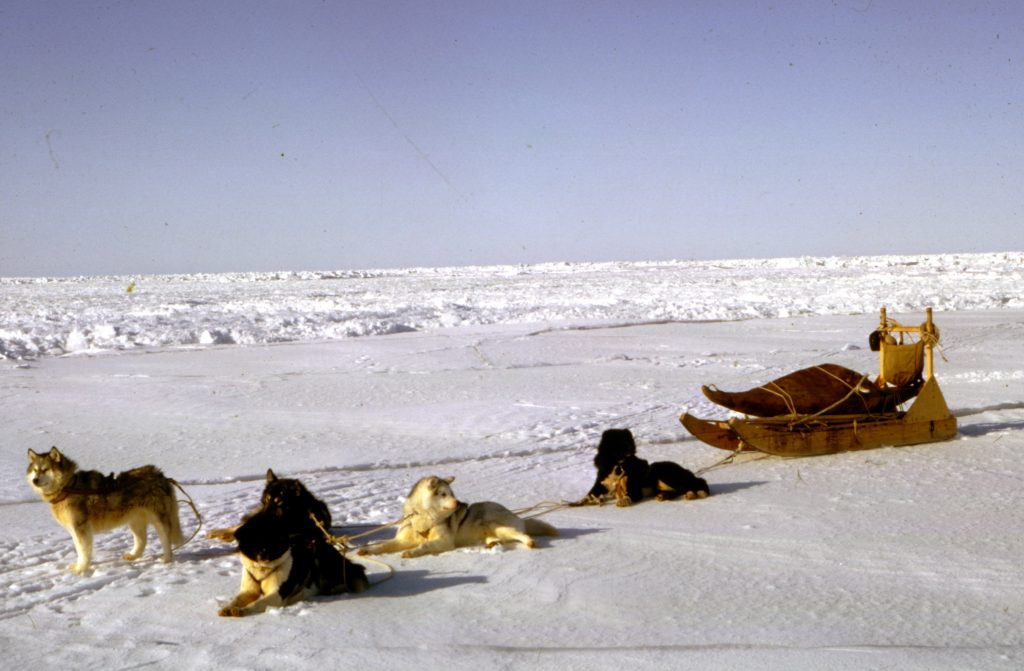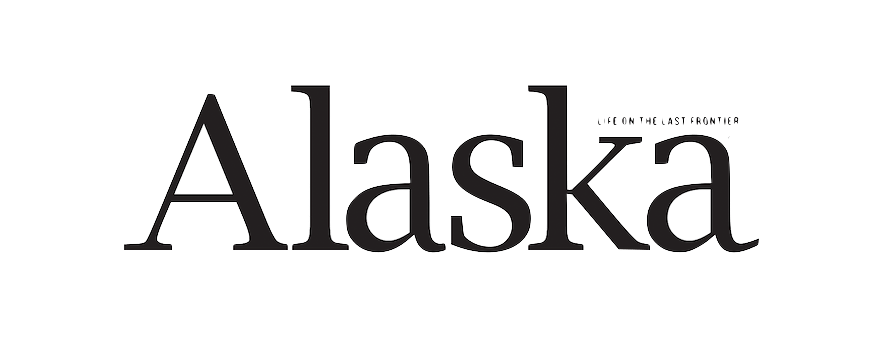Richard K. Nelson catching up on field notes in his Huslia cabin in 1975. Photo courtesy Richard Nelson archive
We fail to recognize such categories are an artifice and the customs surrounding them are pure invention. Throughout human history the artifice of boundary has been a locus for conflict, death and enslavement, ranging from the conflicts among individuals and families to world wars. And in the recent history of our own culture we have built a new border between humanity and the rest of creation. This may be the most dangerous and threatening boundary of all, and the most artificial.
~Richard Nelson, personal journal
Under the plane’s right wing, bright islands of ice floated on a steel-gray sea. Under the left wing, shining puddles and ponds spilled across the flat brown tundra.
Shoulder-to-shoulder with the pilot, a young man in the passenger seat swung his gaze between tundra and sea, mesmerized with his first look at this strange world. The pilot flew with two fingers on the yoke, keeping the single-engine Cessna a mere hundred feet above the beach.
A half hour later, a cluster of low buildings slid into view. The pilot buzzed the village, made a sharp seaward turn, then leveled the plane just above the beach. It hit hard and popped back into the air, bounced twice more, and quickly slowed in the soft black sand. The pilot unloaded his single passenger and a small pile of gear, then hopped into the cockpit. The plane rumbled down the beach, eased aloft and slipped into the wide, gray sky.
A stiff breeze slapped at the young man’s blue jeans and coat. A loose box lid rattled. Small waves lapped the black sand. Inland, a steep bluff rose 15 feet above the shore. Atop the bluff, a growing line of people stood motionless and stared down at the stranger. Somewhere a dog yipped, then broke into a howl. Another dog answered. Hundreds of huskies joined in, voices loud against the wind.
It was the last day of August, 1964, in the village of Wainwright, home to 290 Inupiaq Eskimos and 540 sled dogs. The young man was Richard K. Nelson, an anthropology student from the University of Wisconsin, Madison.
Richard settled into a one-room, government-owned home on the edge of town. That first week, temperatures hovered just above freezing, skies high gray, wind stiff from the northeast. Richard explored the web of muddy paths connecting the small, single-story homes.
Raymond Aguvluk, manager of Wainwright’s only store, was the first to flat-out ask what Richard was up to. Richard explained the Air Force wanted a sea-ice survival manual for pilots flying missions over the Arctic and Antarctic. His job was to interview locals, travel on the ice, and send monthly reports to a cold weather survival research facility in Fairbanks. Raymond listened, nodded, and, with hands clasped behind his head, leaned back and said, “How come they sent you? You don’t know nothing.”
Wainwright
No one was more baffled by his presence in the Arctic than Richard himself. He entered college as a zoology major, intent on channeling his childhood obsession with turtles and snakes into a career in herpetology. When an anthropology professor offered him the chance to travel to the Arctic, Richard’s sense of adventure didn’t allow him to say no.
In 1964, Wainwright had no snow machines—all travel was either on foot or on the back of a sled. After the year’s first snow, Richard bought a few dogs and taught himself to mush. He followed men across the tundra in pursuit of caribou and, later, onto the sea-ice to hunt for seals. Throughout the long winter, Richard never witnessed a conversation that did not, in due time, circle back to hunting. Every exchange, whether in a home or on the trail, drifted to the whereabouts of seals or conditions of ice, the habits of dogs or proximity of bears. Preparing for dangers of Arctic travel, the men shared nuanced knowledge about invisible currents and coming storms, white-out conditions, and emergency camps.

Richard came to see the men’s single-minded focus as the engine of a brilliant, churning intellectual machine. A machine set in motion in the sod houses and ice shelters of their ancestors. A machine combining individual observations to produce insights unavailable to any single hunter.
As the dark winter opened into spring, Richard’s homesickness faded beneath a growing affinity with his Arctic neighbors. As a kid, Richard’s obsession with snakes and frogs was a private affair tolerated, but not shared, by the adults in his life. In Wainwright, his fascination with the natural world slipped from the shadows of a hobby to the full light of essential knowledge. His days, filled with odd foods, elusive humor, new skills, and a foreign language, opened into a deepening sense of home.
Come spring, Richard was scheduled to leave the village the same way he arrived, aboard the Cessna 180 plane operated by the Arctic Research Lab in Utqiagvik. He swept out his little house and hauled bags of gear to the beach. When the plane failed to show, he hauled everything back up the bluff. After several re-scheduled flights also never came, Richard realized a string of dogs fueled by a pile of seal meat was the more reliable way to travel. As the dogs pulled him away from Wainwright, Richard didn’t know memories of the teasing, smiling hunters would form a gravity around which the rest of his life would bend.
Huslia
In the 10 years after leaving Wainwright, Richard earned two graduate degrees, published three books, and walked away from four jobs. He was a rising star in the world of anthropology with book reviews in The New York Times and professorships offered across the country. In classrooms, he was a natural teacher, captivating students with his humor and passion. But city living had no edge. Lecturing about life in wild country was a dull substitute for the life itself.

When offered a contract to map patterns of subsistence use in Alaska’s interior, Richard left academia and settled into Ambler, a small village on the Kobuk River. He bought a team of dogs, cached a winter’s load of wood, and spent the long, cold months apprenticed to local hunters and trappers. Come spring he said farewell to his Ambler neighbors and mushed his team through wind-blasted Dalki Pass, the divide between the Kobuk and Koyukuk Rivers. In Huslia, he staked his dogs alongside a 10-foot by 12-foot cabin belonging to Catherine and Steven Attla. In the coming years, the Attlas would become his greatest teachers and closest of friends.
The Attlas and other village elders constantly spoke of luck—a force which Richard came to see as a state of grace, less about fortune, more about proper relationship with each animal and plant, every mountain, lake or river slough, and all the shifting moods of weather.
Like smoke making wind visible, luck brought shape to the forces hovering just beyond the edge of sight. Luck—a thousand ways to lose it. Once gone, no amount of skill can replace it.
Richard was 34 years old when he left Huslia. He didn’t have an address and owned little more than a wall tent and a surfboard. He ached for the Attlas’ connection to place. He envied their days unfolding alongside the graves of their ancestors. Richard craved a home where each pond and stream, every hill and patch of forest was named and known. He admired his Koyukon teachers “for the surety and comfort of their knowledge, and for the gift of intimacy with nature that my own ancestors let slip away. I’m grateful for what I’ve learned, but sad over what I’ve lost, and troubled by my abiding doubts.”
As I was living among the Koyukon people, nothing struck me more forcefully than the fact that they experience a different reality in the natural world. For the Koyukon, there is a different existence in the forest, something fully actualized within their physical and emotional senses, yet entirely beyond those of outsiders. Although I had lived for several years among other native Alaskan peoples, I had never found access to this element of their lives. The great difference in our points of view was something I had been prepared for intellectually; but I was entirely unprepared for it emotionally, unready for the impact of living it.
~Richard Nelson, Make Prayers to the Raven
Forest and Birds
There were no worn trails of prayer that led Richard to the shores of a rain-forest island. He boated across uncharted waters, drawn by the same yearning that compels others to light a candle or reach for a rosary. Richard went to the island seeking a spiritual path. Hunting, surfing, and watching became his meditation. Writing his discipline. The rainforest his cathedral. The deer his communion. After days, weeks, months rooted in the “unshakable sanity of the senses” Richard was struck by the absurdity in our culture’s insistence in dividing the world into separate bits: self-other, male-female, wild-tame, mine-yours, sacred-profane, organic-inorganic, plant-animal, human-nature…

In a culture lost in the delusion of separateness, Richard became an unlikely, irreverent holy man. He wore no robe. No frock. No cross. Just jeans, tee shirt, and a ball cap. He hated doing his taxes, raged at his computer, swore like a sailor, and ate a peanut butter and jelly sandwich most every day. Yet he dedicated his life to seeing the invisible forces binding us all together. His awareness made him grateful, which made him laugh, which made others want to share his joy.
Richard went to the woods seeking solace for a bruised and cautious heart. He returned, years later, knowing the “rightness of what Koyukon elders teach—that no one is ever alone, unseen, or unheard, and that gratitude kindles the very heat of life.”
In the last days of Richard’s life, bird song played from a speaker perched on the hospital windowsill. Near the end, we humans went quiet. We let the warblers, sparrows, and thrushes speak. I remember robin song, free and clear, interrupted by a raven’s raucous call. The raven called again, sharp and insistent as he drew a final shuddering breath.
Contemplating this inevitable moment, Richard had, years before, scratched these lines in his journal:
If anything remains from me when I die, it should be left on Kruzof Island, where my bones can crumble into that soil and my atoms mingle with the muskeg and moss and lava. There could be no better afterlife for me than to become part of the island – to run through the blood of deer and flow in the muskeg ponds, to fly over the high peaks in the feathers of eagles, to soak with rains into the deep sphagnum. Raven, take my eyes and see with them. Wind, take my breath and sing with it. Hemlock, take my flesh and grow tall with it. Island, take my soul and twist it together with your own.
Editor’s note: Cultural anthropologist and award-winning author Richard K. “Nels” Nelson passed away in 2019 at the age of 77.
Certainty is for those who have learned and believed only one truth. Where I come from, the raven is just a bird – an interesting and beautiful one perhaps, even an intelligent one – but it is just a bird, and that is all. But where I am now, the raven is many other things first, its form and existence as a bird almost the least significant of its qualities. It is a person and a power, God in a clown’s suit, incarnation of a once-omnipotent spirit. The raven sees, hears, understands, reveals…determines. What is the raven? Bird watchers and biologist know. Koyukon elders and their children who listen know. But those like me, who have heard and accepted them both, are left to watch and wonder.
~Richard Nelson, Make Prayers to the Raven


Comments are closed.